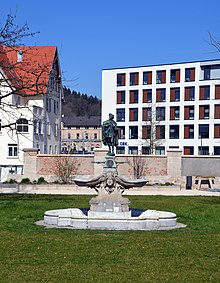City garden (Schwäbisch Gmünd)


The city garden is a park area on the edge of the old town of Schwäbisch Gmünd . This houses the Stahlsche palace and the convention center of the city Congress Centrum Stadtgarten (CCS).
park
The city garden is divided into an eastern, upper city garden, which includes the historical part, and a younger, western part, also known as the lower city garden. In 2014 the city garden was included in the state horticultural show taking place in Schwäbisch Gmünd .
The park was created in 1779 instead of gardens and fields by the later mayor of the city Georg Franz Stahl Edler von Pfeilhalden in 16 fields. It had greenhouses , a pavilion and fountains . Furthermore, the park was decorated with terracotta sculptures that were no longer preserved and were unusual for that time . In 1885 the area went to the factory owner Gustav Hauber, which coined the long familiar name Hauberscher Garten. Instead of the orangery , the Am Stadtgarten 2 building was built in 1889. The baroque planting counted at least one Nordmann fir from the Caucasus , a Douglas fir , a tulip tree and a cypress tree or a tree of life in North America , a blue spruce and a Gelbbuntblättriger and a Weißbuntblättriger Esch maple from America , a direct-colored fir from California , an Austrian black pine , a Juniperus virginiana , a paulownia from Japan , a magnolia from East Asia , a Turkish cherry or blood plum from the Orient , an almond cherry from China and a blood hazel from southern Europe .
There are also various art monuments in the city garden : The sundial pyramid has been in the city garden again since 1994. It was originally made in 1770 and was in the Stahlschen Garten until 1810. Later it belonged to different citizens of Gmünd. Renewals were made in 1956/57 and 1991. Replaced parts are preserved today in the city museum in the Prediger . It is understood as a scholar's piece as well as a game and entertainment instrument and at the same time as an antiquity lover's piece, and thus as a symbol of the essence of the Gmünd upper class at the time of its creation. The Geigerbrünnele is an eight-jet neo-baroque fountain designed by Wilhelm Widemann , which is based on the Geigerle von Gmünd . It was given to the city as a gift by the artist in 1906 and renewed in 1991/92. Another art monument is a reclining lion from 1928. This was created by Eugen Ferdinand Greiner. The baroque figures at the garden gate were created in 1962 based on models by Jakob Wilhelm Fehrle .
Stahlsches Schlösschen
The Stahlsche Schlösschen (also called Rokokoschlösschen ) was built in 1780 according to plans by Gmünd city architect Johann Michael Keller on behalf of Stahl, who gave it to his wife as a present. During the period of frequent changes of ownership, at the latest under Hauber's ownership from 1885, the building was used for catering purposes. In 1926 and 1956 to 1958 there were extensive repairs. The castle is still used for gastronomy today.
As the alternative name suggests, it is a rococo building . The entire building is characterized by delicate rococo handicrafts. The subject of the extensive artistic design is taken from Virgil's Aeneid and Ovid's Metamorphoses . Lauretin Hieber , who had worked for Keller as far as St. Leonhard in 1776 , was accepted as plasterer .
Congress and event center
The CongressCentrum Stadtgarten is located adjacent to the Stadtgarten and bearing its name . In 1898/99, after the city garden fell into the hands of the city, the city garden was built as an event location with several halls and pavilions. After several renovations, the ensemble was demolished in 1980 and replaced by a new building. Today the CongressCentrum Stadtgarten is a venue for a wide range of events, from trade fairs to concerts and party conferences .
literature
- Richard Strobel, State Monuments Office Baden-Württemberg: The art monuments of the city of Schwäbisch Gmünd. Volume 4: Churches and secular buildings outside the old town, districts. Deutscher Kunstverlag, Munich 2003; ISBN 3-422-06381-1 , pp. 152-168.
- Klaus Jürgen Herrmann and Brigitte Mangold: 100 Years of Stadtgarten , in: einhorn Jahrbuch 1998, einhorn, Schwäbisch Gmünd 1998, ISBN 3-927654-67-1 , p. 107 ff.
Web links
Coordinates: 48 ° 47 ′ 57.4 " N , 9 ° 47 ′ 23.4" E

